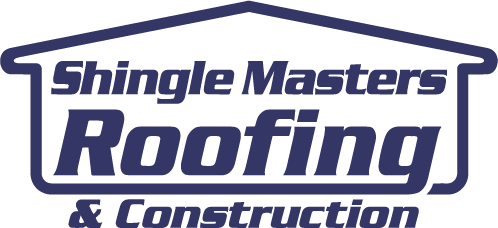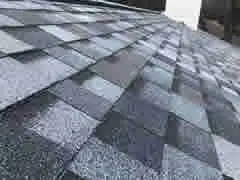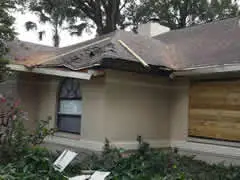Tampa Bay Re-Roof Permits and Florida Code Essentials
Permits, Insurance, and Florida Building Code: What Homeowners in Tampa, Pinellas, Pasco, Manatee, and Sarasota Need to Know Before a Re-Roof
Last updated: October 1st, 2025
Estimated reading time: 10–12 minutes
Key Takeaways
- Permits are mandatory for any re-roof in Hillsborough, Pinellas, Pasco, Manatee, and Sarasota—licensed contractors like ShingleMasters handle the process for you.
- Florida Building Code is hurricane-focused, dictating underlayment, flashing, and fastening to improve wind performance.
- The 25% Rule can require bringing an entire roof section up to current code when repairs exceed 25% within 12 months.
- Wind mitigation inspections (OIR-B1-1802) after installation can unlock substantial insurance discounts.
- Local rules vary across counties and cities—your contractor must know specific local amendments and portals.
Table of Contents
- What You Need to Know
- How It Works / Step-by-Step
- Cost, Timelines & Warranties
- Local Considerations for Tampa Bay Homeowners
- When NOT to Re-Roof / Common Mistakes
- Insurance & Storm Damage Claims
- Why Choose ShingleMasters Roofing
- Glossary of Roofing Terms
- Get a Professional, Code-Compliant Roof
- Sources
- Frequently Asked Questions
What You Need to Know About Florida Re-Roofing Projects
Homeowners in Tampa, Pinellas, Pasco, Manatee, and Sarasota counties must ensure their re-roofing project complies with the Florida Building Code, secures a valid permit from their local authority, and aligns with their homeowner’s insurance requirements to be fully protected. A qualified contractor manages these steps to guarantee a safe and legal installation.
Your Pre-Project Checklist
- Verify your contractor: Ensure they are licensed and insured in the state of Florida.
- Understand the 25% Rule: Ask your contractor how it might apply to your roof’s condition.
- Request a detailed estimate: The quote should clearly list materials, labor, and permit fees.
- Check HOA rules: If applicable, get approval for shingle color and style before applying for a permit.
- Plan for a wind mitigation inspection: Schedule this after completion to secure potential insurance discounts.
- Review your insurance policy: Know your deductible and roof replacement coverage, especially post-storm.
- Ask about warranties: Clarify both manufacturer material warranties and contractor workmanship coverage.
How It Works: The Re-Roofing Process Step-by-Step
A professional roof replacement is a systematic process designed for safety, quality, and code compliance. Here’s how ShingleMasters ensures a smooth project from start to finish.
1) Professional Inspection & Estimate
- Who: A ShingleMasters project manager.
- What: Comprehensive inspection of the roofing system, measurements, ventilation/structural review, and a written estimate with scope, materials, and clear pricing.
- Duration: 1–2 hours.
2) Permitting & Documentation
- Who: The ShingleMasters administrative team.
- What: Complete permit application with your local building department (e.g., City of Tampa, Pinellas County), including engineering documents and product approvals required by the Florida Building Code.
- Duration: A few days to several weeks, depending on the municipality.
3) Material Selection & Delivery
- Who: You and your ShingleMasters consultant.
- What: Choose shingle type, style, and color. After permit approval, materials (shingles, underlayment, flashing, vents) are ordered and delivered 1–2 days before work begins.
- Duration: 1–3 days.
4) Installation & Inspections
- Who: ShingleMasters’ certified crew and the city/county inspector.
- What: Property protection (tarps/plywood), tear-off, deck repairs, and installation per manufacturer specs and Florida Building Code. In-progress inspections coordinated with the local inspector.
- Duration: 2–5 days for most homes; inspector visits during this phase as scheduled.
5) Final Cleanup & Final Inspection
- Who: Our crew and the city/county inspector.
- What: Thorough cleanup with magnetic nail sweep. Final inspection scheduled with the building department; the inspector confirms code compliance and closes the permit.
- Duration: Cleanup ~1 day; final inspection timing depends on inspector availability.
6) Warranty & Project Completion
- Who: ShingleMasters and you.
- What: Delivery of material and workmanship warranty documentation after passing final inspection. Assistance scheduling a wind mitigation inspection (OIR-B1-1802) for insurance discounts.
- Duration: Warranty documents typically delivered within 1–2 weeks.
What Do New Roofs Cost, How Long Do They Take & What Is the Warranty?
The cost of a new roof in Florida depends on roof size/complexity, materials, and labor rates. A professional contractor manages permitting and inspections, but timelines vary with the local building department’s schedule.
Material vs. workmanship warranties: Material warranties cover defects in products; workmanship warranties cover installation errors. “Lifetime” typically means for as long as you (the original owner) own the home and is often prorated after an initial period.
Typical Roofing Material Comparison
| Material | Wind Rating | Impact Class | Typical Warranty | Typical Cost Range (per sq. ft. installed) |
|---|---|---|---|---|
| Architectural Shingles | Up to 130 mph (with proper installation) | Class A Fire, Impact varies | “Lifetime” Limited (prorated after 10–25 years) | $4.50 – $7.00 |
| Impact-Resistant Shingles | Up to 130 mph | Class 4 | “Lifetime” Limited + Hail Damage | $5.50 – $9.00 |
| Standing Seam Metal | 140+ mph | Class 4 | 20–50 years | $9.00 – $16.00 |
| Clay/Concrete Tile | 130+ mph | Class 3 or 4 | 50+ years | $12.00 – $25.00 |
Disclaimer: Costs are estimates for planning purposes only and vary based on market conditions, roof complexity, and contractor. Wind and impact ratings depend on the specific product and proper installation. Verify all warranty details with the manufacturer.
Local Considerations for Tampa Bay Homeowners
Navigating the specific rules of your city or county is crucial. The Florida Building Code sets statewide standards, but local jurisdictions can add amendments and unique processes. While HVHZ provisions primarily apply to South Florida, our region still enforces robust wind and water-intrusion requirements.
County vs. City Permitting
If you’re inside city limits (Tampa, St. Petersburg, Clearwater, Sarasota, Bradenton), your contractor will pull a permit from that city’s building department. If you’re in an unincorporated area, the permit is handled by the county (e.g., Hillsborough County Planning and Development or the Pinellas County Access Portal).
- Hillsborough County: Manages permits for unincorporated areas like Brandon and Riverview.
- City of Tampa: Has its own application and inspection process.
- Pinellas County: Handles unincorporated areas; cities like St. Pete and Clearwater manage their own.
- Pasco County: Oversees a large unincorporated area with specific submission requirements.
- Manatee & Sarasota Counties: Each maintains county-level permitting portals for unincorporated areas.
Pro tip: A local roofer like ShingleMasters knows which office to use and what paperwork is required—preventing delays and fines.
HOA and Historic District Approvals
Before applying for a permit, obtain written approval from your HOA for material type, color, and style. If you’re in a designated historic district (e.g., Ybor City or parts of St. Petersburg), your project may require additional review by a historic preservation board to maintain architectural character. Expect added time and potential material limitations.
When NOT to Re-Roof / Common Mistakes to Avoid
- Do not hire an unlicensed or uninsured contractor. They cannot legally pull a permit, and you could be liable for injuries. Verify licenses on the Florida DBPR site.
- Do not skip the building permit. It’s the law. Skipping permits can trigger fines, stop-work orders, and issues with home sales or insurance claims.
- Do not pay 100% upfront. A reputable contractor uses a reasonable deposit with the balance due after completion and passed final inspection.
- Do not ignore “small” leaks. Water travels—leading to hidden deck, insulation, and drywall damage, mold, and costly structural repairs.
- Do not sign an Assignment of Benefits (AOB) without legal review. Be cautious with any contract that transfers your claim rights to a contractor.
Insurance & Storm Damage Claims Explained
When a hurricane, hailstorm, or severe wind damages your roof, follow a clear process: secure the property from further damage, document everything, file a claim, and have a trusted roofer meet your adjuster. Your contractor will perform the approved scope and assist with paperwork to release any recoverable depreciation.
Disclaimer: This is not legal or insurance advice; verify coverage details and processes with your insurance carrier.
Your 8-Point Insurance Checklist After a Storm
- Review your policy: Locate your documents and check your hurricane/named-storm deductible (often a % of insured value).
- Document everything: Capture clear photos/videos of exterior damage and any interior water spots.
- Prevent further damage: Tarp leaks and keep receipts for temporary materials.
- Call your insurance carrier: Open a claim to receive a claim number and adjuster assignment.
- Call a reputable roofer: Get an independent inspection from a trusted contractor like ShingleMasters.
- Schedule the adjuster meeting: Ensure your roofer attends to identify all damage and discuss code requirements.
- Understand the Scope of Loss: Review the adjuster’s scope with your contractor for completeness and accuracy.
- Know how payments work: Typically paid as ACV first, then recoverable depreciation after completion and final invoice.
Why Choose ShingleMasters Roofing for Your Tampa Bay Home?
Navigating permits, building codes, and insurance claims is complex. ShingleMasters simplifies the process—handling paperwork, coordinating inspections, and delivering a safe, compliant installation with transparent pricing.
- Certified Installers: Crews trained by leading manufacturers like GAF and Owens Corning.
- Robust Warranties: Comprehensive workmanship coverage plus manufacturer lifetime limited warranties.
- Safety First: Strict safety protocols protect your property and our team.
- Clean Job Site: Daily protection and meticulous cleanup, including magnetic nail sweeps.
- Flexible Financing: Options available to make essential projects more affordable.
- Local Experts: From Tampa to Sarasota, we understand regional codes and weather challenges.
Explore our roof replacement guide or contact our team to learn more about storm damage repair options.
Glossary of Roofing Terms
- Underlayment: A water-resistant barrier installed on the roof deck beneath shingles. Florida code often requires self-adhering underlayment for superior water intrusion protection.
- Ridge Vent: An exhaust vent at the roof peak that allows warm, moist attic air to escape.
- Class 4 Impact Rating: Highest impact resistance—tested by dropping a 2-inch steel ball from 20 feet without causing cracks or splits.
- Ice & Water Shield: A common term for self-adhering underlayment used in valleys, eaves, and other critical leak-prone areas.
- O&P (Overhead and Profit): An estimate line item covering a general contractor’s operating costs and profit, often included for complex projects.
- Flashing: Metal pieces that prevent water intrusion at junctions (e.g., chimneys, walls, valleys).
- Roof-to-Wall Connection: The method attaching roof trusses to walls; hurricane straps/clips are key and reviewed in wind mitigation inspections.
Get a Professional, Code-Compliant Roof for Your Florida Home
Don’t let the complexities of permits and insurance stand in the way of protecting your home. The ShingleMasters team manages every detail—delivering a safe, durable, and beautiful new roof.
Schedule your free, no-obligation inspection today and receive a clear, upfront quote from the team you can trust.
If you only do 3 things…
- Get a professional inspection: Understand your roof’s true condition before deciding.
- Verify your contractor’s license: Check potential roofers on the Florida DBPR portal.
- Read your insurance policy: Know your deductible and coverage before you need it.
Sources
- Florida Building Code, 8th Edition (2023), Residential — International Code Council
- The 25-percent Roof Replacement Rule in Florida — Williams PA
- Wind Mitigation — Florida Division of Emergency Management
- Hillsborough County Building & Construction Permits — Hillsborough County
- Pinellas County Access Portal — Pinellas County
- Pasco County Building Construction Services — Pasco County, FL
- GAF Shingle & Accessory Limited Warranty — GAF
- Owens Corning Roofing Limited Warranties — Owens Corning
Frequently Asked Questions
How long does a roof replacement take?
Most residential replacements in Tampa Bay take 2–5 days from start of installation to cleanup. The full project timeline (including permitting, material delivery, and final inspection) can span several weeks—the permit approval process is often the biggest variable.
Is a Class 4 impact-rated shingle worth it in Florida?
Class 4 impact shingles provide the highest level of impact resistance. While large hail is less frequent in coastal Florida, these shingles add peace of mind and may qualify for insurance premium discounts.
Can I repair my roof instead of replacing it?
Yes—if damage is isolated and the rest of the roof is sound. However, per the Florida Building Code’s 25% Rule, if more than a quarter of a roof section is affected within 12 months, you may need to replace that entire section (or, in some cases, the entire roof) to meet current code.
What is the Florida Building Code’s 25% Rule?
If you repair, replace, or recover more than 25% of a roof section within a 12-month period, that entire section must be brought up to current code standards—improving hurricane resistance and overall safety.
How much can I save with a wind mitigation inspection?
Savings vary by carrier, home location, and roof features. A new, code-compliant roof often includes elements inspectors look for—like proper roof-to-wall connections and a sealed roof deck—which can maximize discounts.
Do I need a permit to repair a few shingles?
Generally, minor repairs to a very small area do not require a permit. Thresholds vary by municipality, and any significant work—especially work that triggers the 25% Rule—does require a permit. Consult a licensed contractor to be sure.



